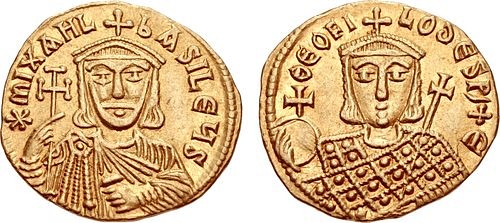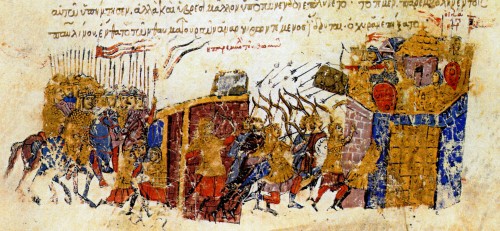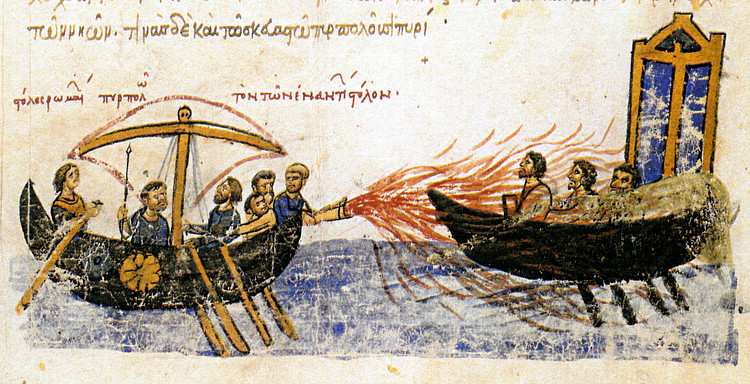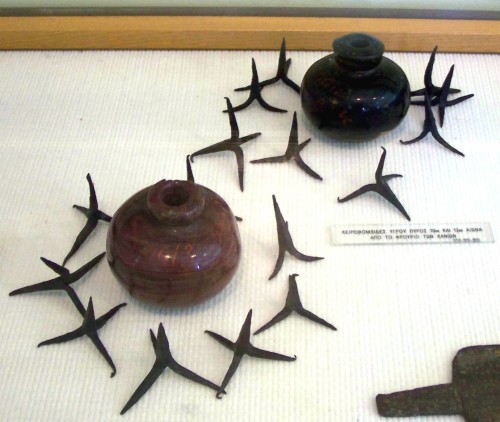Michael II › Greek Fire » Ancient origins
Articles and Definitions › Contents
- Michael II › Who Was
- Greek Fire › Antique Origins
Ancient civilizations › Historical and archaeological sites
Michael II › Who Was
Definition and Origins

Michael II the Amorion, also known as Michael “the Stammerer”, was emperor of the Byzantine Empire between 820 and 829 CE. He founded the short-lived Amorion dynasty, named after his hometown in Phrygia, which would last until 867 CE.Surviving the major rebellion and siege of Constantinople led by Thomas the Slav, the emperor's reign witnessed little else of success as the empire continued to crumble at its edges, with Sicily and Crete being notable losses.
SUCCESSION
Michael hailed from the strategically important city of Amorion (aka Amorium) in Phrygia, the capital of the military province of Anatolikon. Amorion protected the road from the Cilician Gates to the Byzantine capital Constantinople. Michael was a seasoned military commander in the Byzantine army and is described by the historian JJ Norwich as "a bluff, unlettered provincial…of humble origins, with an impediment in his speech" (131). Michael rose to become Emperor Leo V the Armenian’s (r. 813-820 CE) right-hand man and was given the top job of Commander of the Excubitors, an elite regiment of the palace guard.
Michael wanted rather more, though, and he took his chance and seized the throne in 820 CE in one of the most shameless and shocking episodes of self-promotion the Byzantines had witnessed, and they had seen a good few over the centuries.Michael's supporters did not go for the quiet stab in the back down a dark alley assassination plot but murdered the reigning emperor right in front of the altar of the Hagia Sophia church, and on Christmas day of all days.
MICHAEL WAS SAVED FROM EXECUTION BY HIS SUPPORTERS WHO DISGUISED THEMSELVES AS A CHOIR OF MONKS & BUTCHERED THE EMPEROR.
Actually, Michael and his supporters had been rather pushed into this dramatic action as he had just been condemned to death by Leo the day before - the novel method of execution decided upon involved tying the victim to an ape and putting the pair into the furnaces which heated the palace baths (quite what the ape had done to deserve his sentence is unclear). Michael, accused of plotting a rebellion and confessing his guilt, had been due to be executed on Christmas Day but Leo was persuaded by his wife Theodosia that such an act was not a particularly appropriate one for that special day and so the sentence was postponed to the day after. The decision was a fateful one, and Michael was saved from this ignominious end by his supporters who disguised themselves as a choir of monks and butchered the emperor. Leo proved not such an easy target, though, and he defended himself, according to legend, with a large metal cross for an hour before finally succumbing to the assassins who lopped off his head.

The Byzantine Empire in the mid-9th century CE
Michael II was immediately released from his prison and crowned, still wearing his chains around his ankles as no one could find the keys. Meanwhile, Leo's mutilated body was dragged naked around the Hippodrome of Constantinople for public ridicule. Leo's wife and children were exiled to the Princes' Islands where the four sons were subsequently castrated. The Isaurian dynasty, which had had eight emperors, one empress, and ruled since 717 CE, was swept away, and the Amorion dynasty begun.
THOMAS THE SLAV
Fortunately, Michael benefitted from Leo V's defeat of the Bulgars in 814 CE and the sudden death of their leader, the Khan Krum. A 30-year peace allowed both the Bulgars and Byzantines to concentrate on other threats. Unfortunately, though, almost immediately, Michael had to defend his throne against a rival usurper, the fellow general Thomas the Slav (although actually from Gaziura in Asia Minor ). Rallying support from those outraged at Leo V's murder and backed by all but two of the provinces ( themes ) in Asia Minor, Thomas led a damaging three-year rebellion against Michael's regime.
The charming and wily Thomas made sure he appealed to just about every group who might have a grievance against the emperor - the overtaxed poor, those in the Church who opposed Michael's (albeit moderate) stance against the veneration of icons in the Byzantine Church, and even those old followers of the deposed Constantine VI (r. 780-797 CE) - bizarrely, Thomas even claimed to actually be the blinded Constantine VI and had himself crowned as such in Antioch. Thomas, unknown to the majority of his followers, was actually receiving cash from the Caliph Mamun (r. 813-833 CE) and in return, he would probably have turned Constantinople into a fiefdom of the Abbasid Caliphate.
Crucially, Thomas could also call on the naval fleet of the province of Kibyrrhaiotai, located along the southern coast of Asia Minor, and the height of the crisis came when Thomas besieged Constantinople from the sea in December 821 CE. Heavy winter storms saw off the initial attacks, and then, in the longer term, the massive fortifications of the city, the Theodosian Walls, and the judicious placement of catapults and mangonels ensured the capital resisted Thomas' own catapults and siege engines.

Thomas the Slav Attacks Constantinople
The emperor was also fortunate to have the Bulgar Khan Omurtag (r. 814-831 CE) as an ally. Omurtag's army helped to finally break the stalemate and end the siege in March 823 CE. Thomas' army was crushed on the plain of Keduktos near Heraclea and swept up by Michael's force riding out from the capital. Thomas fled the scene and, with a mere handful of followers, barricaded himself in the fortified town of Arcadiopolis. Michael pursued his foe and laid siege to the town, nicely reversing the roles of attacker and defender. Thomas held out for a few months, but he and his men were forced to eat their own horses to survive. Finally, in October 823 CE, Michael offered a pardon to the defenders if Thomas was handed over. Thus, the would-be usurper was captured and executed, first having his feet and hands cut off and then his body impaled on a stake.
THERE WERE SIGNIFICANT DEFEATS AT THE HANDS OF THE ARABS IN BOTH CRETE & SICILY.
THE ERODING EMPIRE
Michael might have survived a siege at home and put down the greatest rebellion the Byzantine Empire had ever witnessed but farther afield events were anything but encouraging. There were significant defeats at the hands of the Arabs in both Crete and Sicily in 825 CE and 827 CE respectively. Crete, in particular, became a major problem for just about everyone in the Mediterranean as it turned into an impregnable base for pirates, while the city of Candia (Heraklion) developed into the biggest slave market in the region. Michael launched three separate attacks on the island between 827 and 829 CE but all failed to retake it. The loss of parts of Sicily would also have significant repercussions as the Arabs used it, like so many armies before and after them, as a landing stage to attack and conquer southern Italy.
RELATIONSHIP WITH THE CHURCH
Michael had been only a moderate iconoclast who did not take very much interest in the debate which some of his predecessors had fuelled by their persecution of those who venerated icons. He even pardoned such notable iconophiles as Theodore of Studium, and his moderate policies generally made him popular with both sides of the debate. One area which did ruffle some ecclesiastical feathers was the emperor's second marriage. As an important representative of the Church, the ruler was not meant to remarry, but after Michael's first wife Thecla died, he married Euphrosyne, the daughter of Constantine VI. To make matters worse, Euphrosyne was a nun. Nevertheless, Michael managed to get around the Church and the past vows of his betrothed to marry his new sweetheart, who, with her royal blood, also gave his reign and, more importantly, his heir, an air of legitimacy.
DEATH & SUCCESSOR
Michael died of natural cause in October 829 CE and he was succeeded by his son Theophilos (r. 829-842 CE), then aged just 25. It was Theophilos who would continue where Leo V had left off to vehemently continue the destruction of icons in the Church and the persecution of those who venerated them. Theophilos was succeeded by his son Michael III (r. 842-867 CE), the last of the Amorion emperors whose early reign was dominated by his regent mother Theodora.
Greek Fire › Antique Origins
Definition and Origins

Greek Fire was an incendiary weapon first used in Byzantine warfare in 678 CE. The napalm of ancient warfare, the highly flammable liquid was made of secret ingredients and used both in catapulted incendiary bombs and sprayed under pressure so as to launch flames at enemy ships and fortifications. It was also used with success in defensive situations. Greek Fire became the most devastating weapon of Christendom for over seven centuries and ensured that Constantinople resisted all comers. Emperor Romanos II (r. 959-963 CE) knew its value and declared three things must absolutely never reach foreign hands: the Byzantine imperial regalia, any royal princess, and Greek Fire. As it turned out, the first two were, on occasion, bestowed on foreign rulers but never the third.
A SECRET FORMULA
The invention of Greek Fire is credited to a Christian Greek named Kallinikos (aka Callinicus) who escaped to Constantinople from Muslim-held Syria in 668 CE. Flammable liquids had been used in both Greek and Roman warfare but nothing had ever been devised that was quite as lethal as Greek Fire. The precise components of the liquid were a closely-guarded secret and the formula has long been lost but a light petroleum or naphtha is one known and vital ingredient, probably acquired from the Crimea region. Other ingredients were quicklime, sulphur, resin and potassium nitrate. Some scholars suggest gunpowder was included in the mix. The process of making the liquid was a highly dangerous one, given its volatility. Distilling the petroleum element also required complex technology for the period. Known to only a select few, the recipe for Greek Fire was a jealously guarded state secret which emperors passed on to their successors. Thanks to these precautions the secret formula was kept in Byzantine hands alone for over seven centuries.
GREEK FIRE INSTANTANEOUSLY SET SHIPS ABLAZE & THERE WAS NO WAY OF PUTTING OUT THE FLAMES AS WATER HAD NO EFFECT ON THEM.
USE IN BATTLE
Greek fire was first used in naval engagements where streams of the flaming liquid were fired under pressure towards enemy ships. The ships which usually carried Greek Fire were of the dromon type, a fast-sailing vessel which could also be propelled using oars. The exact design of the firing device is not known except that it was made from bronze tubes and included a syphon pump and swivelling nozzle. The apparatus must have been complex because an example and the necessary liquid fuel were once captured by a Bulgar force but they could not manage to actually use it. A 12th century CE illuminated manuscript, the Madrid Skylitzes, contains an illustration of one of Michael II ’s (r. 820-829 CE) ships shooting Greek Fire from a long tube towards a ship of Thomas the Slav during the latter's siege of Constantinople in 821-822 CE. In 2006 CE a full-size replica was constructed by John Haldon using reconstructed parts and Crimean oil. The endeavour was a success, firing intense flames 10 to 15 metres distant which were capable of incinerating anything in their path in seconds.
The dramatic effect of Greek Fire and the method of spraying it, according to the 6th century CE Byzantine historian Theophanes, “caused enemies to shiver in terror” (Bagnall, 2984). Just about anything on board an enemy vessel that came into contact with the liquid was immediately set ablaze - rigging, sails, men and even the ship's hull. Worse, there was no way of putting out the fire as water had no effect on it. A peculiar quality which made the weapon even more shocking was that it burned especially well on water. There was very little defence against it either - covering the ship in soaked hides, maintaining a safe distance or attacking during storms were all attempted without much success.
The Greeks began to fling their fire all around; and the Rusii seeing the flames threw themselves in haste from their ships, preferring to be drowned in the water rather than burned alive in the fire.(Liutprand of Cremona, Antapodosis, describing a Byzantine battle in 941 CE)
VITAL VICTORIES
The almost magical weapon was sorely needed in the latter half of the 7th century CE. The Arab World was biting great chunks out of the Christian Mediterranean and their fleet seemed invincible. They conquered Sicily, Tarsus, great swathes of North Africa and even the mighty fortress of Rhodes. They then set their sights on the very heart of the Byzantine empire : Constantinople itself. The Arab ships formed three fleets, audaciously captured an island opposite the capital and then settled down to besiege the city for four long years. The Byzantines needed a miracle from the God who seemed to have forsaken them. In Greek Fire they certainly found one. Sailing out to meet the Arab fleet with their ships spouting flames, the enemy was routed. The trick was repeated against another Arab fleet only a few decades later in 718 CE, this time after suffering a one-year blockade.
It is impossible to exaggerate the importance of Greek Fire in Byzantine history. (JJ Norwich, 176)

Greek Fire Grenades
Time and again Greek Fire was used to devastating effect in naval warfare, notably by Romanos I (r. 919-944 CE) in 941 CE and Constantine IX (r. 1042-1055 CE) a century later, both against attacking Russian fleets. John I Tzimisces (r. 969-976 CE) used Greek Fire to good effect on land in 972 CE when he bashed his way into Preslav, the Bulgar capital which the Russians had captured, and so was able to liberate the Bulgar king. In 988-9 CE Basil II (r. 976-1025 CE) devastatingly combined Greek Fire with his magnificent force of Vikings, the Varangian Guard, to utterly quash the rebellion of the usurper Bardas Phokas.The military successes of the Byzantine empire and particularly the conviction that Constantinople was “God's protected city” were, then, in no small part due to Kallinikos' lethal invention.
ADAPTATIONS & DECLINE
Over time the full potential for Greek Fire was realised by adapting its use for land warfare. Portable pumps were devised so that flames could be fired either at or from fortifications. Another innovation was to fill clay grenades with the liquid or soak bales of cloth and catapult them into the enemy ranks. Its most devastating use remained, though, in naval warfare, where it was also used in unmanned fire ships sent with prevailing winds into the very heart of an enemy fleet - a tactic confirmed in the 1204 CE siege of Constantinople. For unknown reasons the use of Greek Fire is unrecorded from the Fourth Crusade (1202-1204 CE) onwards but for many centuries it had been the most important weapon in world warfare and crucial in the defence of the Byzantine empire.
LICENSE:
Article based on information obtained from these sources:with permission from the Website Ancient History Encyclopedia
Content is available under License Creative Commons: Attribution-NonCommercial-ShareAlike 3.0 Unported. CC-BY-NC-SA License